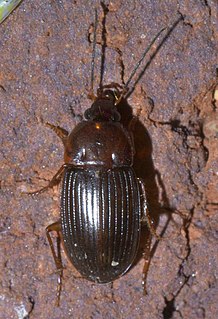
Calathus is a genus of ground beetle native to the Palearctic, the Near East and North Africa. There are at least 190 described species in Calathus.

Cassida is a large Old World genus of tortoise beetles in the subfamily Cassidinae. Several species of Cassida are important agricultural pests, in particular C. vittata and C. nebulosa on sugar beet and spinach. The thistle tortoise beetle has been used as a biological control agent against Canada thistle.
Hydrochara spangleri is a species of water scavenger beetle in the family Hydrophilidae. It is found in North America.
Teretrius latebricola is a species of clown beetle in the family Histeridae. It is found in North America.
Atholus falli is a species of clown beetle in the family Histeridae. It is found in North America.
Amara patruelis is a species of seed-eating ground beetle in the family Carabidae. It is found in North America.
Xyleborus horridus is a species of typical bark beetle in the family Curculionidae. It is found in North America.

Bembidion incrematum is a species of ground beetle in the family Carabidae. It is found in North America.
Thysanoes texanus is a species of typical bark beetle in the family Curculionidae. It is found in North America.
Physea hirta is a species of ground beetle in the family Carabidae. It is found in Central America and North America.
Bembidion planiusculum is a species of ground beetle in the family Carabidae. It is found in North America.
Palorus subdepressus, the depressed flour beetle, is a species of darkling beetle in the family Tenebrionidae.

Anatrichis minuta is a species of ground beetle in the family Carabidae. It is found in North America.
Gastrellarius unicarum is a species of woodland ground beetle in the family Carabidae. It is found in North America.

Rhyncolus is a genus of true weevils in the beetle family Curculionidae. There are at least 140 described species in Rhyncolus.
Onthophilus lecontei is a species of clown beetle in the family Histeridae. It is found in North America.
Hydroporus despectus is a species of predaceous diving beetle in the family Dytiscidae. It is found in North America.
Paracymus confluens is a species of water scavenger beetle in the family Hydrophilidae. It is found in North America.
Paracymus nanus is a species of water scavenger beetle in the family Hydrophilidae. It is found in the Caribbean and North America.
Paracymus subcupreus is a species of water scavenger beetle in the family Hydrophilidae. It is found in North America.







